Intensification of Sulfuric Acid Leaching of Altered Ilmenite via Adding Fluoride Activator
Abstract
:1. Introduction
2. Materials and Methods
2.1. Chemical Composition of Ilmenite Concentrate
2.2. Experimental Methods and Procedures
3. Results and Discussion
3.1. Influence of Input Parameters of Sulfate Acid–Fluoride Leaching Process
3.1.1. Experimental Design
3.1.2. Response Surface Methodology and Analysis
3.2. Optimization of the Molar Ratio Value of Ti:F in the Reaction Mixture
3.3. Optimization of the Process Temperature Value
3.4. Optimization of Sulfuric Acid Concentration Value
3.5. Flow Sheet of the Leaching Process of Altered Ilmenite
- (1)
- sulfate acid leaching of ilmenite concentrates following the removal of iron compounds from reacting media;
- (2)
- sulfate acid–fluoride leaching of rutile-containing sludge (not dissolved in the previous stage), in the presence of sodium fluoride.
4. Conclusions
- 1.
- Sulfuric acid leaching of the altered ilmenite concentrate is carried out under the following conditions: concentration of sulfuric acid = 85 wt.%, process temperature = 190 °C, the mass ratio of solid:liquid = 1:2.
- 2.
- Sulfate–fluoride leaching of rutilized sludge (raw materials that did not dissolve in the previous stage) is carried out under the following conditions: addition of sodium fluoride to the reaction mixture in a molar ratio of Ti:F = 1:2 and the mass ratio of solid:liquid = 1:2, process temperature = 100 °C, concentration of sulfuric acid = 85 wt.%.
Author Contributions
Funding
Institutional Review Board Statement
Informed Consent Statement
Data Availability Statement
Conflicts of Interest
References
- Kalashnikova, A.; Nikolenko, N.; Kalashnikov, J.; Kostynyuk, A. Rutile-anatase Composite Catalyst Formed by Coupling Anatase and Rutile Particles. Chem. Mater. Eng. 2013, 1, 88–95. [Google Scholar] [CrossRef]
- Hasan Omidi, M.; Salmani Nuri, O.; Tavakoli, H. Optimization of Ilmenite Dissolution by Synergistic Effect of Oxalic Acid and Hydrochloric Acid for Preparing Synthetic Rutile. Int. J. Nonferrous Metall. 2018, 7, 25–38. [Google Scholar] [CrossRef] [Green Version]
- Titanium Dioxide Market Size, Share & Trends Analysis Report by Application (Paints & Coatings, Plastics, Pulp & Paper, Cosmetics), by Region (APAC, North America, Europe), and Segment Forecasts, 2021–2028. Available online: https://www.grandviewresearch.com/industry-analysis/titanium-dioxide-industry (accessed on 15 June 2021).
- Belardi, G.; Piga, L.; Quaresima, S.; Shehu, N. Application of physical separation methods for the upgrading of titanium dioxide contained in a fine waste. Int. J. Miner. Process. 1998, 53, 145–156. [Google Scholar] [CrossRef]
- Zubkov, L.B. Space Metal. All about Titanium [Kosmicheskij Metall. Vsyo o Titane]; Nauka: Moscow, Russia, 1987. [Google Scholar]
- Liu, Y.M.; Lü, H.; Qi, T.; Zhang, Y. Extraction behaviours of titanium and other impurities in the decomposition process of ilmenite by highly concentrated KOH solution. Int. J. Miner. Metall. Mater. 2012, 19, 9–14. [Google Scholar] [CrossRef]
- Jabłoński, M.; Przepiera, A. Kinetic model for the reaction of ilmenite with sulphuric acid. J. Therm. Anal. Calorim. 2001, 65, 583–590. [Google Scholar] [CrossRef]
- Kostova, N.G.; Achimovičová, M.; Eliyas, A.; Velinov, N.; Blaskov, V. TiO2 obtained from mechanically activated ilmenite and its photocatalytic properties. Bulg. Chem. Commun. 2015, 47, 317–322. [Google Scholar]
- Mehdilo, A.; Irannajad, M. Effects of mineralogical and textural characteristics of ilmenite concentrate on synthetic rutile production. Arab. J. Geosci. 2013, 6, 3865–3876. [Google Scholar] [CrossRef]
- Wei, D.; Jun-Hui, X.; Yang, P.; Si-Yue, S.; Tao, C.; Kai, Z.; Zhen, W. Extraction of Scandium and Iron from Red Mud. Miner. Process. Extr. Metall. Rev. 2020, 1–8. [Google Scholar] [CrossRef]
- Lavecchia, R.; Piga, L.; Pochetti, F.; Chacon, L. Production of titanium chloride by chlorination of ilmenite with carbon tetrachloride. Trans. Inst. Min. Metall. Sect. C Miner. Process. Extr. Metall. 1993, 102, 174–178. [Google Scholar]
- Wahyuningsih, S.; Ramelan, A.H.; Munifa, R.M.I.; Saputri, L.N.M.Z.; Chasanah, U. Synthesis of TiO2 nanorods from titania and titanyl sulfate produced from ilmenite dissolution by hydrothermal method. J. Phys. Conf. Ser. 2016, 776, 1–6. [Google Scholar] [CrossRef]
- Jabłoński, M.; Tylutka, S. The influence of initial concentration of sulfuric acid on the degree of leaching of the main elements of ilmenite raw materials. J. Therm. Anal. Calorim. 2016, 124, 355–361. [Google Scholar] [CrossRef]
- Nie, W.; Wen, S.; Liu, D.; Zhang, Q.; Liu, J.; Feng, Q. Leaching behaviors of impurities in titanium-bearing electric furnace slag in sulfuric acid. Processes 2020, 8, 56. [Google Scholar] [CrossRef] [Green Version]
- Kalashnykov, Y.V.; Nikolenko, N.V.; Kachalova, A.S.; Dubenko, A.V.; Abramova, A.M. Effect of mechanical activation of malyshevsky ilmenite on its phase composition and leaching rate. Vopr. Khimii Khimicheskoi Tekhnologii 2015, 2015, 63–71. [Google Scholar]
- Dubenko, A.V.; Nikolenko, M.V.; Kostyniuk, A.; Likozar, B. Sulfuric acid leaching of altered ilmenite using thermal, mechanical and chemical activation. Minerals 2020, 10, 538. [Google Scholar] [CrossRef]
- Gerasimova, L.G.; Maslova, M.V. Hydrothermal behavior of titanium(IV) sulfate solutions. Russ. J. Inorg. Chem. 2012, 57, 313–319. [Google Scholar] [CrossRef]
- Liang, B.; Li, C.; Zhang, C.; Zhang, Y. Leaching kinetics of Panzhihua ilmenite in sulfuric acid. Hydrometallurgy 2005, 76, 173–179. [Google Scholar] [CrossRef]
- Zhang, S.; Nicol, M.J. Kinetics of the dissolution of ilmenite in sulfuric acid solutions under reducing conditions. Hydrometallurgy 2010, 103, 196–204. [Google Scholar] [CrossRef] [Green Version]
- Han, K.N.; Rubcumintara, T.; Fuerstenau, M.C. Leaching behavior of ilmenite with sulfuric acid. Metall. Trans. B 1987, 18, 325–330. [Google Scholar] [CrossRef]
- Nikolenko, N.V.; Dubenko, A.V.; Vashkevich, E.Y.; Dmitrikova, L.V. Temperature optimum of the process of the dissolution of altered ilmenite in sulfuric acid. Vopr. Khimii Khimicheskoi Tekhnologii 2018, 3, 70–78. [Google Scholar]
- Liu, W.; Lü, L.; Yue, H.; Liang, B.; Li, C. Combined production of synthetic rutile in the sulfate TiO2process. J. Alloys Compd. 2017, 705, 572–580. [Google Scholar] [CrossRef]
- Xiong, X.; Wang, Z.; Wu, F.; Li, X.; Guo, H. Preparation of TiO2 from ilmenite using sulfuric acid decomposition of the titania residue combined with separation of Fe3+ with EDTA during hydrolysis. Adv. Powder Technol. 2013, 24, 60–67. [Google Scholar] [CrossRef]
- Goroschenko, Y.G.; Belyakova, E.P.; Kozachek, N.N.; Dvernyakova, A.A. Technical Titanium Dioxide and Its Production from Altered Ilmenite by the Sulfuric Acid Method [Tekhnicheskaya Dvuokis’ Titana i eyo Poluchenie iz Izmenennogo Il’menita Sernokislotnym Metodom]; Scheka, I.А., Ed.; Naukova Dumka: Kyiv, Ukraine, 1968. [Google Scholar]
- Gordienko, P.S.; Dostovalov, V.A.; Pashnina, E.V. Hydrofluoride method of complex processing of titanium-containing raw materials. Solid State Phenom. 2017, 265, 542–547. [Google Scholar] [CrossRef]
- Malina, K.M. Spravochnik Sernokislotchika [Sulfur Acid Guide], 2nd ed.; Khimiya: Moscow, Russia, 1971. [Google Scholar]
- Dorozhkin, S.V. Calcium orthophosphates in nature, biology and medicine. Materials 2009, 2, 399–498. [Google Scholar] [CrossRef] [Green Version]
- Chen, B.; Bao, S.; Zhang, Y. Synergetic strengthening mechanism of ultrasound combined with calcium fluoride towards vanadium extraction from low-grade vanadium-bearing shale. Int. J. Min. Sci. Technol. 2021, in press. [Google Scholar] [CrossRef]
- Chyliński, F.; Kuczyński, K. Ilmenite mud waste as an additive for frost resistance in sustainable concrete. Materials 2020, 13, 2904. [Google Scholar] [CrossRef]
- Chyli´nski, F.; Bobrowicz, J.; Łukowski, P. Undissolved ilmenite mud from TiO2 production—waste or a valuable addition to portland cement composites? Waste or a Valuable Addition to Portland Cement Composites. Materials. 2020, 13, 3555. [Google Scholar] [CrossRef]
- Chen, D.; Jiang, Z.; Geng, J.; Zhu, J.; Yang, D. A facile method to synthesize nitrogen and fluorine co-doped TiO2 nanoparticles by pyrolysis of (NH4)2TiF 6. J. Nanopart. Res. 2009, 11, 303–313. [Google Scholar] [CrossRef]
- Pong, T.K.; Besida, J.; O’Donnell, T.A.; Wood, D.G. A Novel Fluoride Process for Producing TiO2 from Titaniferous Ore. Ind. Eng. Chem. Res. 1995, 34, 308–313. [Google Scholar] [CrossRef]
- Rodriguez, M.H.; Rosales, G.D.; Pinna, E.G.; Tunez, F.M.; Toro, N. Extraction of titanium from low-grade ore with different leaching agents in autoclave. Metals 2020, 10, 497. [Google Scholar] [CrossRef] [Green Version]
- Sachkov, V.I.; Nefedov, R.A.; Orlov, V.V.; Medvedev, R.O.; Sachkova, A.S. Hydrometallurgical processing technology of titanomagnetite ores. Minerals 2018, 8, 2. [Google Scholar] [CrossRef] [Green Version]
- Biswas, R.K.; Habib, M.A.; Dafader, N.C. A study on the recovery of titanium from hydrofluoric acid leach solution of ilmenite sand. Hydrometallurgy 1992, 28, 119–126. [Google Scholar] [CrossRef]
- Hansen, A.D.; Traut, E.D.; Fisher, G.T. Extraction of Titanium and Iron From Ilmenite. Tech. Rep. USA Report of Investigations No 9557 1995, 1995, 1–12. [Google Scholar]
- Gupta, A.K.; Aula, M.; Pihlasalo, J.; Mäkelä, P.; Huttula, M.; Fabritius, T. Preparation of synthetic titania slag relevant to the industrial smelting process using an induction furnace. Appl. Sci. 2021, 11, 1153. [Google Scholar] [CrossRef]
- Karelin, V.A.; Kameneva, O.V. Ftoridnyiy metod pererabotki rutilovogo kontsentrata [Fluoride processing method of rutile concentrate]. Bull. Tomsk Polytech. Univ. 2006, 309, 94–99. (In Russian) [Google Scholar]
- Hansen, D.A.; Traut, D.E. The kinetics of leaching rock ilmenite with hydrofluoric acid. JOM 1989, 41, 34–36. [Google Scholar] [CrossRef]
- Biswas, R.K.; Mondal, M.G.K. A study on the dissolution of ilmenite sand. Hydrometallurgy 1987, 17, 385–390. [Google Scholar] [CrossRef]
- Hansen, D.A.; Traut, D.E.; Fisher, G.T. Extraction of Titanium and Iron from Ilmenite with Fluosilicic Acid. Available online: https://stacks.cdc.gov/view/cdc/10135 (accessed on 22 June 2021).
- Guo, H.; Kuang, G.; Li, H.; Pei, W.T.; Wang, H. dong Enhanced lithium leaching from lepidolite in continuous tubular reactor using H2SO4+H2SiF6 as lixiviant. Trans. Nonferrous Met. Soc. China 2021, 31, 2165–2173. [Google Scholar] [CrossRef]
- Langley, R.H.; Schmitz, C.K.; Langley, M.B. The synthesis and characterization of some fluoride perovskites, an undergraduate experiment in solid state chemistry. J. Chem. Educ. 1984, 61, 643. [Google Scholar] [CrossRef] [Green Version]
- Karelin, V.A.; Karelin, A.I. Ftoridnaya Tehnologiya Pererabotki Kontsentratov Redkih Metallov [Fluoride Concentrates], Technology for Processing Rare Metal; NTL: Tomsk, Russia, 2004; ISBN 5895031277. [Google Scholar]
- Xiao, J.; Peng, Y.; Ding, W.; Chen, T.; Zou, K.; Wang, Z. Recovering Scandium from Scandium Rough Concentrate. Processes 2020, 8, 365. [Google Scholar] [CrossRef] [Green Version]
- Dubenko, A.V.; Nikolenko, N.V.; Velichenko, A.B.; Suschinskii, A.D. Thermodynamic modeling of sulfate-acid and sulfate-fluoride leaching of titanium. Vopr. Khimii Khimicheskoi Tekhnologii 2020, 3, 69–76. [Google Scholar] [CrossRef]
- Dubenko, A.V.; Nikolenko, M.V.; Aksenenko, E.V.; Kostyniuk, A.; Likozar, B. Mechanism, thermodynamics and kinetics of rutile leaching process by sulfuric acid reactions. Processes 2020, 8, 640. [Google Scholar] [CrossRef]
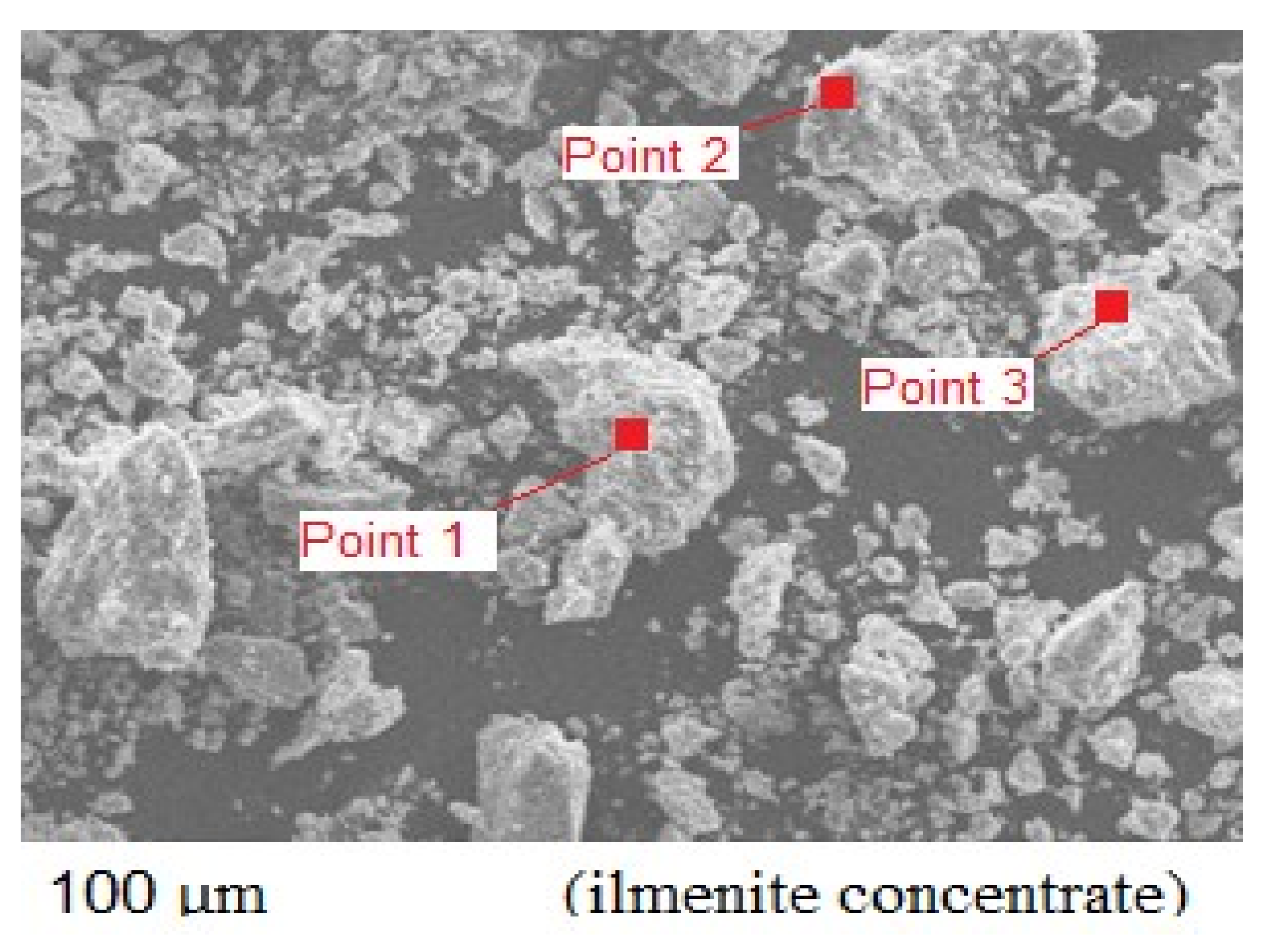
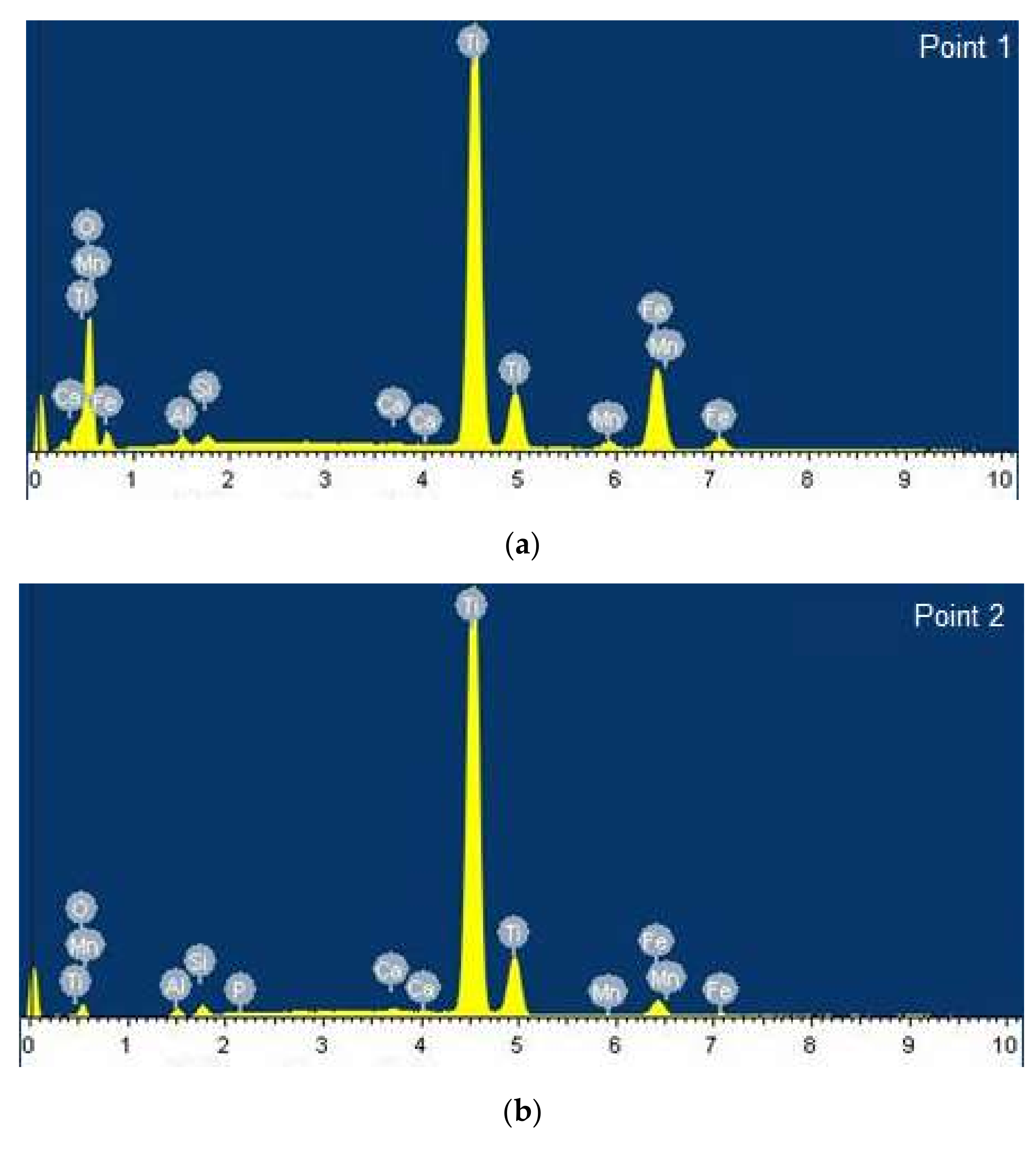
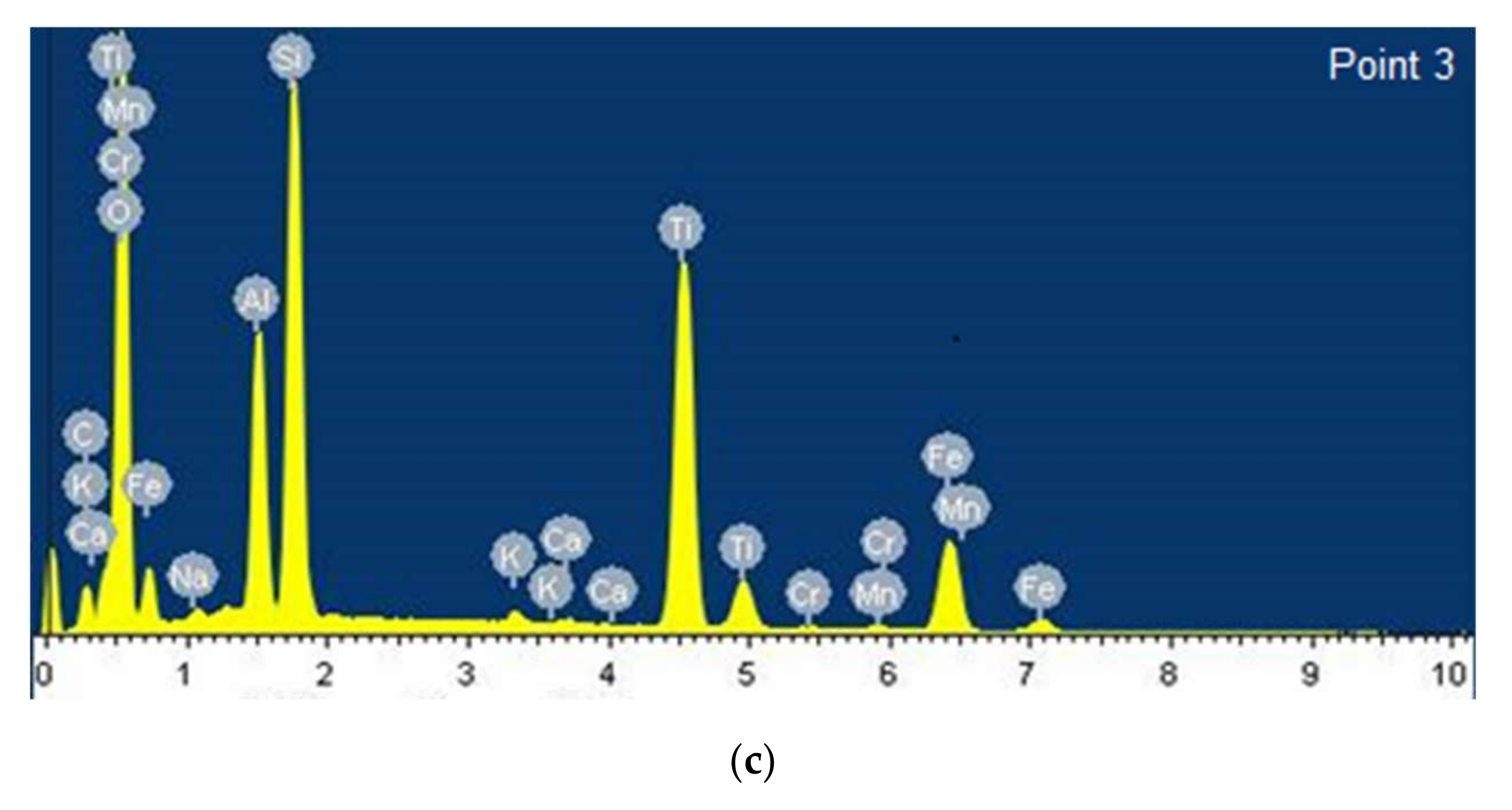
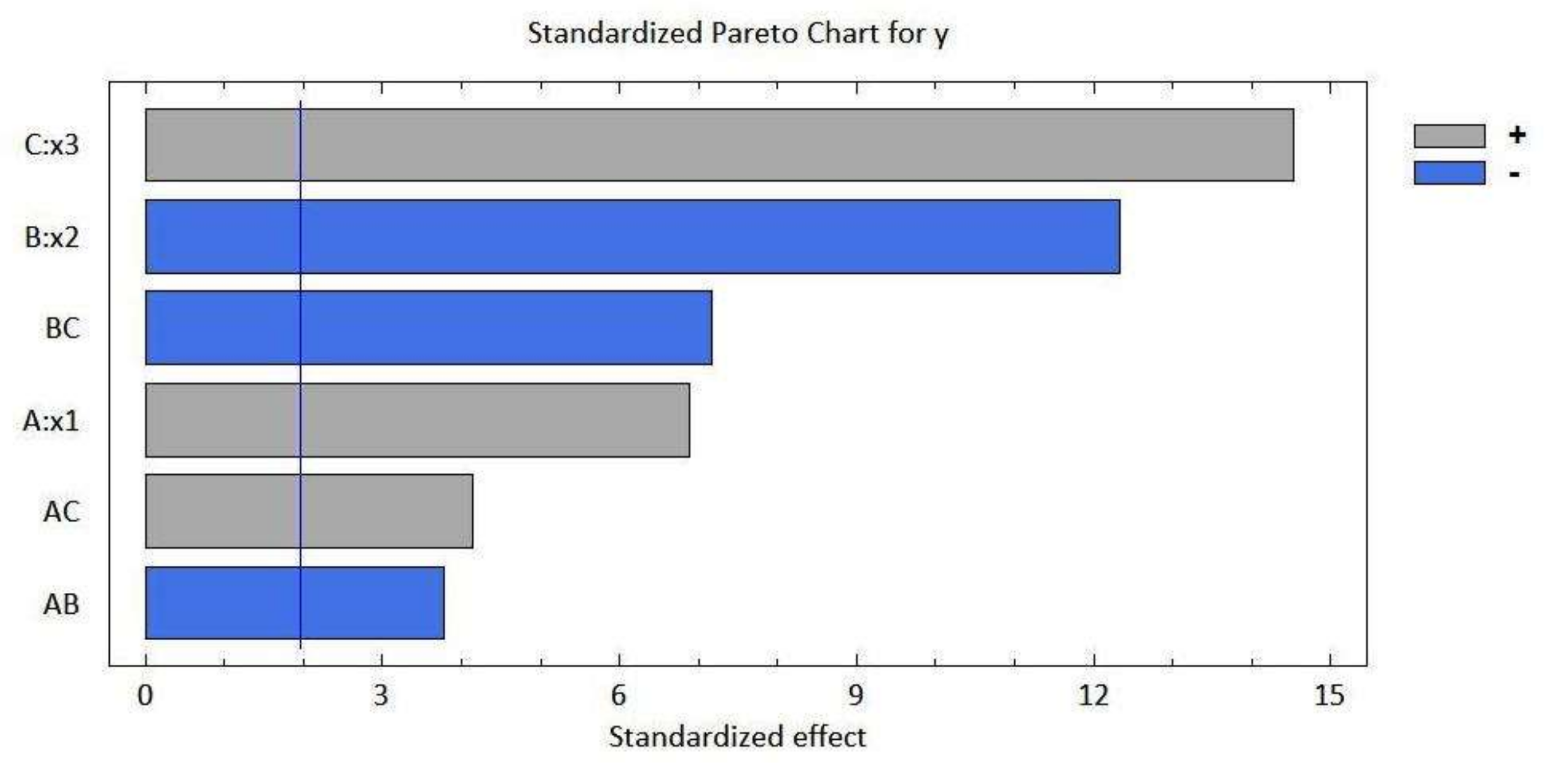

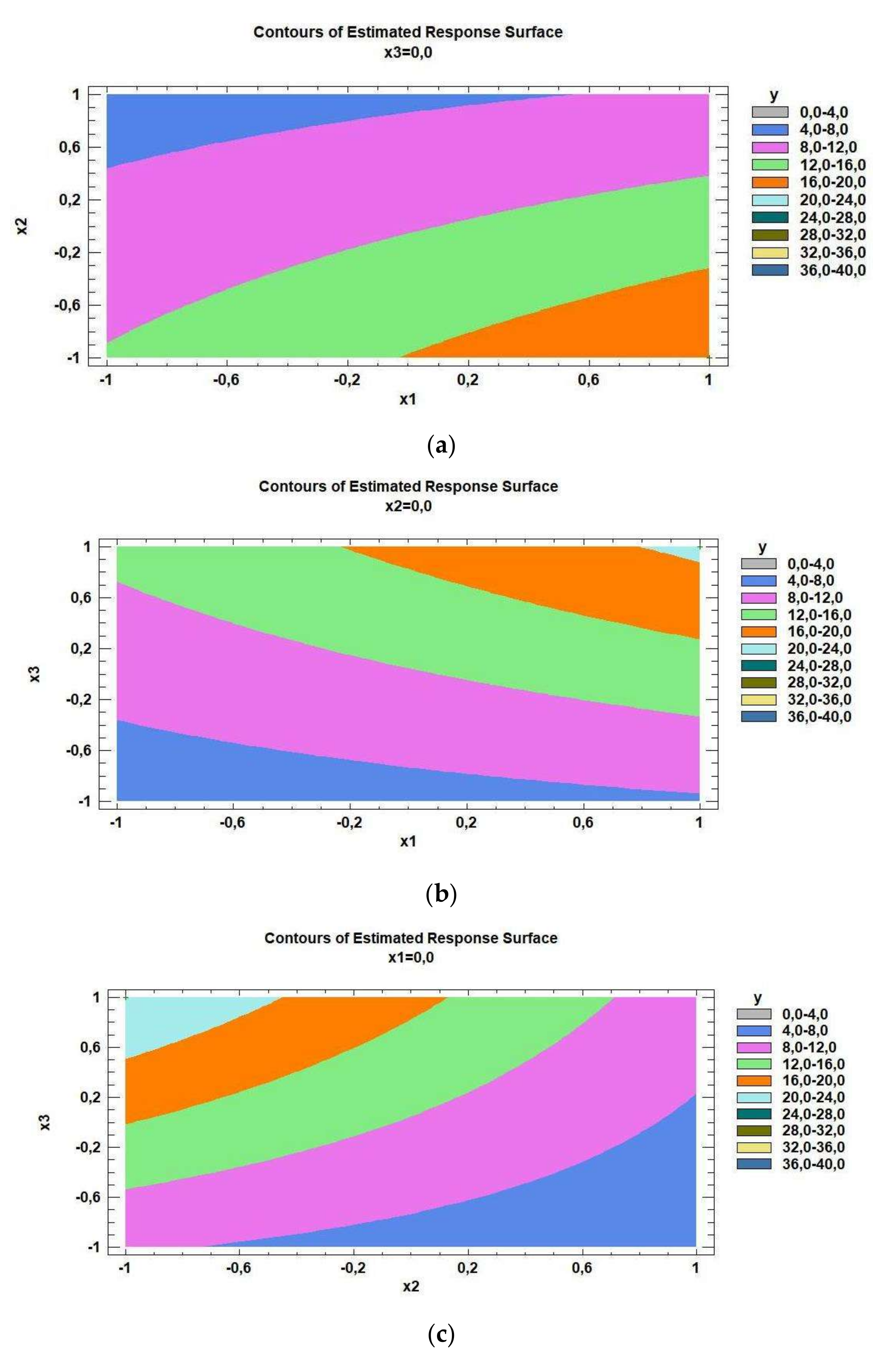


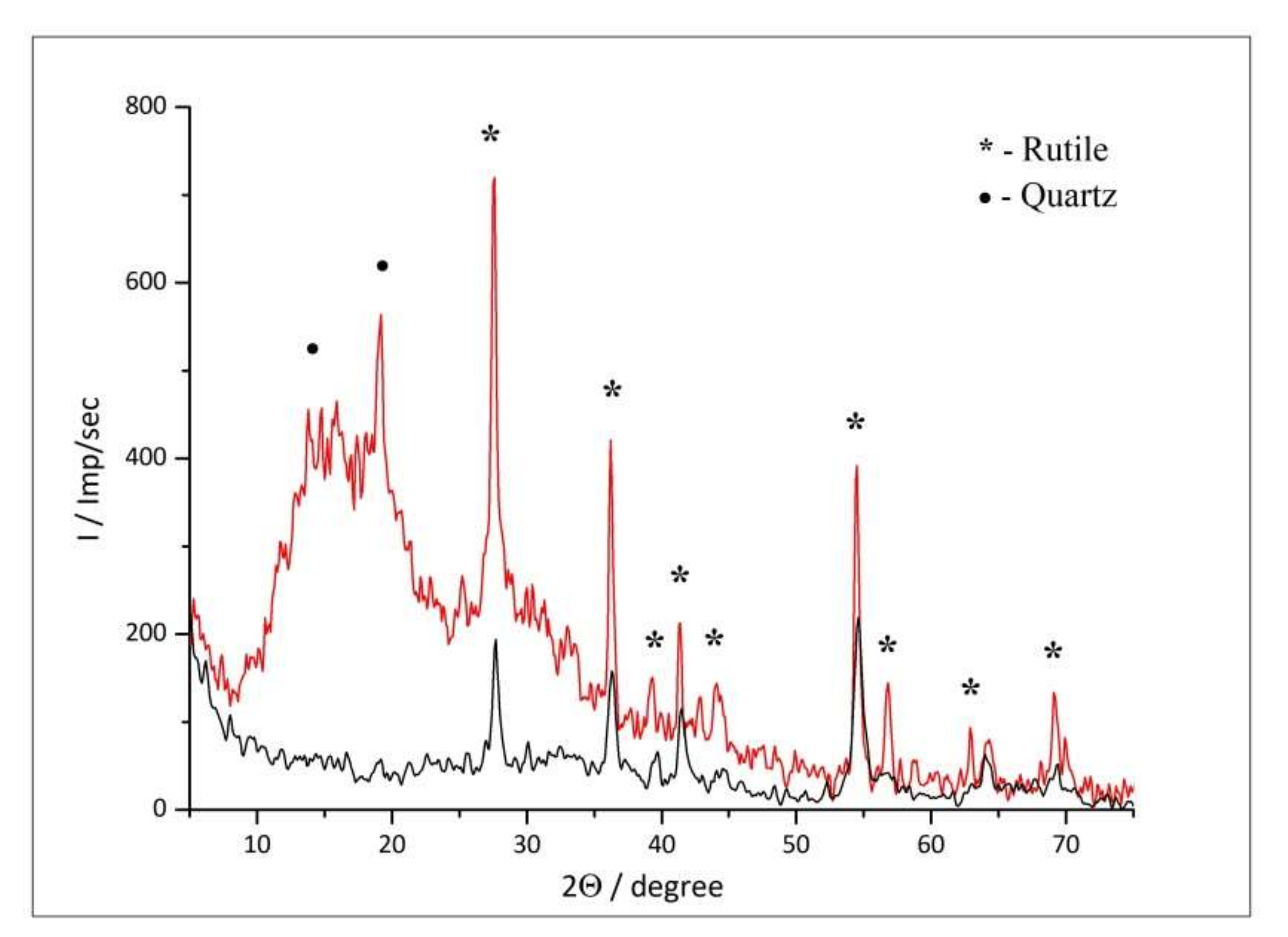


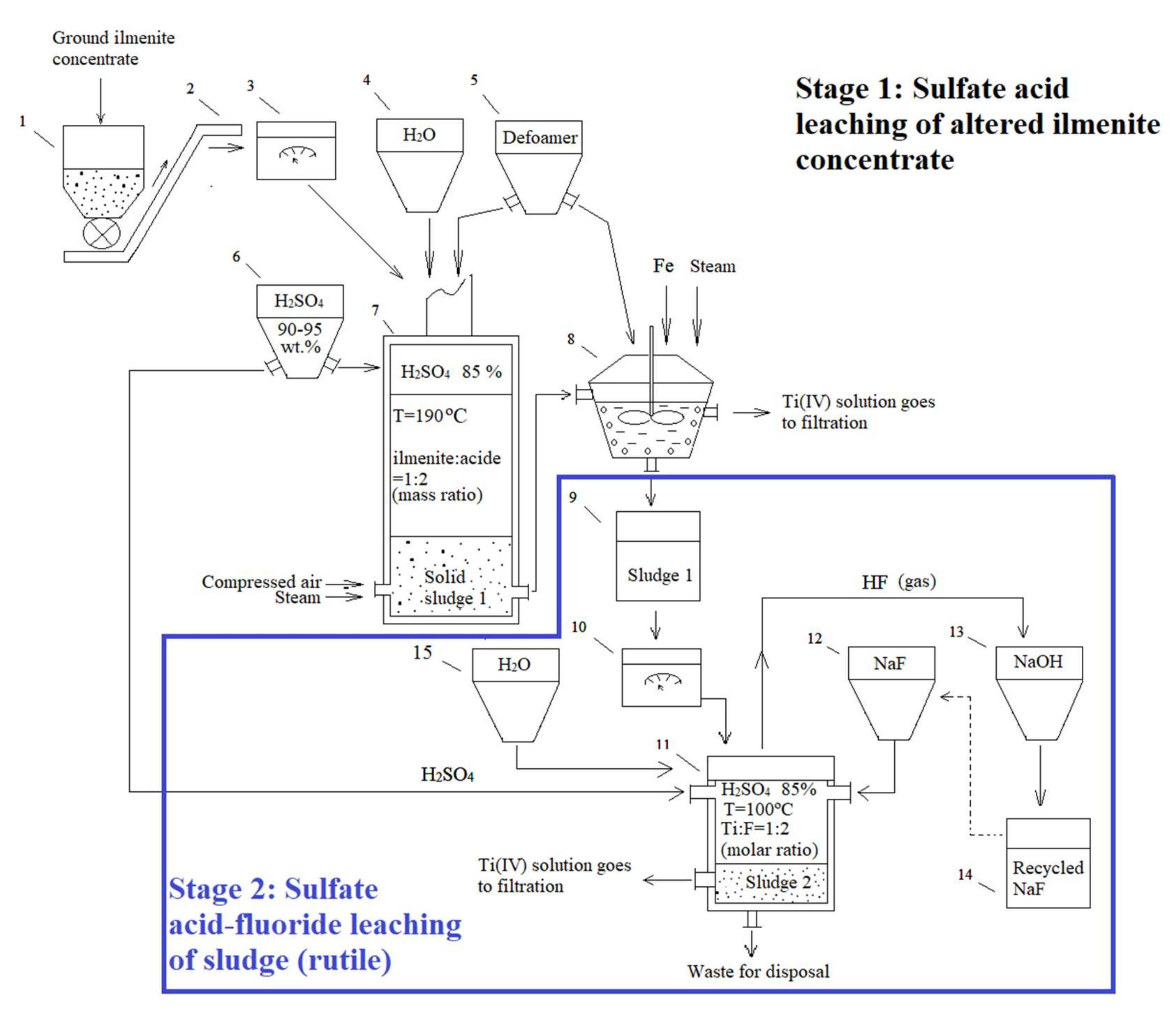
| Element | Ti | Fe | Mg | Mn | Cr | P | V | Al | Si | Ca | O |
| ω, wt.% | 41.0 | 19.9 | 0.540 | 0.190 | 0.100 | 0.080 | 0.120 | 0.420 | 0.370 | 0.040 | 37.2 |
| Oxide | TiO2 | SiO2 | Cr2O3 | Al2O3 | Moisture |
| ω, wt.% | 68.5 ± 1.2 | 0.71 ± 0.24 | 0.14 ± 0.07 | 0,35 ± 0.11 | 0.15 ± 0.08 |
| Parameters | Coded Levels | |||
|---|---|---|---|---|
| Definition | Independent Variable | −1 | 0 | +1 |
| x1 | The molar ratio of components Ti:F | (1:1) | (1:1.5) | (1:2) |
| x2 | The concentration of sulfuric acid, wt.% | 85 | 90 | 95 |
| x3 | The process temperature, °C | 70 | 85 | 100 |
| Experimental Number | x1 | x2 | x3 | x1x2 | x1x3 | x2x3 | , % |
|---|---|---|---|---|---|---|---|
| 1 | − | − | − | + | + | + | 7.20 |
| 2 | + | − | − | − | + | − | 9.70 |
| 3 | − | + | − | − | − | + | 4.10 |
| 4 | + | + | − | + | − | − | 5.50 |
| 5 | − | − | + | + | + | − | 17.50 |
| 6 | + | − | + | − | − | + | 30.10 |
| 7 | − | + | + | − | − | − | 8.50 |
| 8 | + | + | + | + | + | + | 11.50 |
| Source | Sum of Squares | Df | Mean Square | F-Ratio | p-Value | Remarks |
|---|---|---|---|---|---|---|
| A:x1 | 47.5313 | 1 | 47.5313 | 47.53 | 0.0000 | Significant |
| B:x2 | 152.251 | 1 | 152.251 | 152.25 | 0.0000 | |
| C:x3 | 211.151 | 1 | 211.151 | 211.15 | 0.0000 | |
| AB | 14.3112 | 1 | 14.3112 | 14.31 | 0.0002 | |
| AC | 17.1113 | 1 | 17.1113 | 17.11 | 0.0000 | |
| BC | 51.5113 | 1 | 51.5113 | 51.51 | 0.0000 | |
| Total error | 9.03125 | 1 | 9.03125 | 9.03 | 0.0027 | |
| External sigma | 1.0 | |||||
| Total (corr.) | 502.899 | 7 | ||||
| The R-Squared Results | ||||||
| R-squared | 98.2042% | |||||
| R-squared (adjusted for d.f.) | 87.4291% | |||||
| Standard Error of Est | 3.0052 | |||||
| Mean Absolute Error | 1.0625 | |||||
Publisher’s Note: MDPI stays neutral with regard to jurisdictional claims in published maps and institutional affiliations. |
© 2021 by the authors. Licensee MDPI, Basel, Switzerland. This article is an open access article distributed under the terms and conditions of the Creative Commons Attribution (CC BY) license (https://creativecommons.org/licenses/by/4.0/).
Share and Cite
Dubenko, A.V.; Nikolenko, M.V.; Pasenko, O.O.; Kostyniuk, A.; Likozar, B. Intensification of Sulfuric Acid Leaching of Altered Ilmenite via Adding Fluoride Activator. Processes 2021, 9, 1922. https://doi.org/10.3390/pr9111922
Dubenko AV, Nikolenko MV, Pasenko OO, Kostyniuk A, Likozar B. Intensification of Sulfuric Acid Leaching of Altered Ilmenite via Adding Fluoride Activator. Processes. 2021; 9(11):1922. https://doi.org/10.3390/pr9111922
Chicago/Turabian StyleDubenko, Anastasiia V., Mykola V. Nikolenko, Oleksandr O. Pasenko, Andrii Kostyniuk, and Blaž Likozar. 2021. "Intensification of Sulfuric Acid Leaching of Altered Ilmenite via Adding Fluoride Activator" Processes 9, no. 11: 1922. https://doi.org/10.3390/pr9111922






